The cosmetic ingredients for hair removal market is projected to grow steadily from USD 4.8 billion in 2025 to USD 9.1 billion by 2035, reflecting a compound annual growth rate (CAGR) of 6.6%. Between 2025 and 2030, the market will expand from USD 4.8 billion to USD 6.6 billion, driven by the growing demand for effective, safe, and convenient hair removal solutions. This demand is largely attributed to increasing consumer awareness about the importance of personal grooming and the rising preference for at-home hair removal products.
As these ingredients are incorporated into a variety of cosmetic products, including creams, gels, and waxing solutions, the market is experiencing steady growth, with manufacturers focusing on enhancing product formulations to improve efficacy and user experience. From 2030 to 2035, the market is expected to further increase from USD 6.6 billion to USD 9.1 billion, maintaining a consistent growth trajectory. This period will see more innovations in cosmetic ingredients tailored to meet diverse consumer needs, such as hypoallergenic and dermatologically tested formulations. With increasing focus on hair removal products that offer convenience, affordability, and skin benefits, the market is set for continued expansion.
The ongoing preference for self-care and grooming, coupled with a growing variety of options in both professional and DIY hair removal products, is expected to fuel sustained growth in the years ahead. As consumer behavior continues to favor effective and user-friendly solutions, market opportunities are expected to increase across regional and global markets.
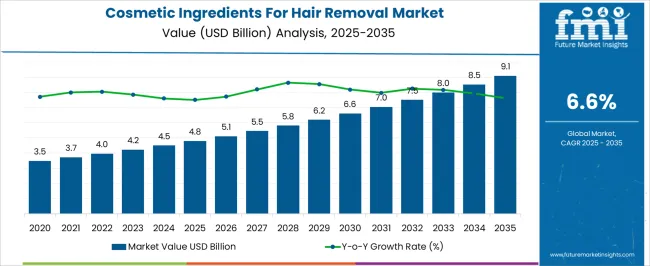
| Metric | Value |
|---|---|
| Cosmetic Ingredients For Hair Removal Market Estimated Value in (2025 E) | USD 4.8 billion |
| Cosmetic Ingredients For Hair Removal Market Forecast Value in (2035 F) | USD 9.1 billion |
| Forecast CAGR (2025 to 2035) | 6.6% |
The cosmetic ingredients for hair removal market holds a specialized position within its parent markets. Within the broader Cosmetic Ingredients Market, it accounts for approximately 6% of the total market share, reflecting its niche application in personal care products. In the Hair Removal Products Market, which encompasses various hair removal solutions, the cosmetic ingredients segment comprises about 10% of the market share, indicating its role in enhancing the efficacy and appeal of these products.
Within the Personal Care Ingredients Market, the hair removal segment holds a share of approximately 5%, driven by the increasing demand for effective and skin-friendly hair removal solutions. In the Hair Care Ingredients Market, which focuses on products for hair maintenance and styling, the hair removal ingredients segment represents about 2% of the market share, highlighting its specialized application.
In the Personal Care Specialty Ingredients Market, the hair removal segment accounts for around 3%, underscoring its importance in formulating products that cater to specific consumer needs. These figures illustrate the Cosmetic Ingredients for Hair Removal Market's role as a distinct yet impactful niche across multiple personal care sectors, driven by consumer demand for effective and gentle hair removal solutions.
The market is experiencing consistent growth, supported by the rising demand for effective and skin-friendly depilatory solutions. The shift toward natural and safe formulations has been accelerating adoption across both professional and at-home hair removal applications. Consumer preferences are increasingly aligned with products that combine efficacy with minimal skin irritation, prompting manufacturers to incorporate ingredients that enhance performance while maintaining skin health.
The market is also benefiting from heightened grooming awareness and expanding personal care expenditure across emerging economies. Innovation in formulation technology, including the integration of bio-based and hypoallergenic components, is enabling brands to cater to diverse skin types and hair textures.
Strategic marketing, coupled with product diversification, is further strengthening brand positioning. With the convergence of natural ingredient demand, improved manufacturing capabilities, and growing distribution networks, the market is set for sustained expansion, offering significant opportunities for ingredient suppliers and formulation specialists in the coming years.
The cosmetic ingredients for hair removal market is segmented by type, category, application, and geographic regions. By type, cosmetic ingredients for hair removal market is divided into Glyceryl rosinate (rosin)/gum rosin, Hydrogenated rosin, Beeswax, Essential oils, Thioglycolic acid, Lanolin, Glycerin, and Others. In terms of category, cosmetic ingredients for hair removal market is classified into Natural waxing ingredients and Synthetic waxing ingredients. Based on application, cosmetic ingredients for hair removal market is segmented into Soft wax and Hard wax. Regionally, the cosmetic ingredients for hair removal industry is classified into North America, Latin America, Western Europe, Eastern Europe, Balkan & Baltic Countries, Russia & Belarus, Central Asia, East Asia, South Asia & Pacific, and the Middle East & Africa.
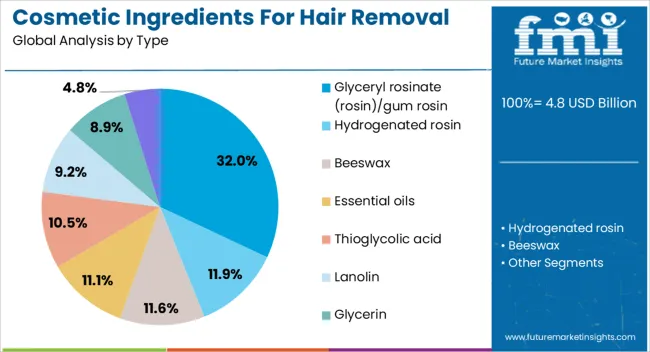
The Glyceryl Rosinate (rosin)/gum rosin type segment is projected to hold 32% of the Cosmetic Ingredients for Hair Removal market revenue share in 2025, making it the leading type. The segment’s prominence has been driven by its strong adhesion properties, which facilitate efficient hair removal with minimal residue. Its compatibility with various wax formulations has increased its use across both salon-grade and home-use products.
Derived from natural sources, glyceryl rosinate offers a favorable balance of performance and consumer acceptance, particularly among users seeking eco-conscious and skin-safe ingredients. The ability of this ingredient to maintain consistent viscosity and stability under different temperature conditions has further enhanced its suitability for a range of product formats.
Its proven track record in delivering effective results, combined with versatility in blending with other natural components, has contributed to its strong market presence The segment is expected to maintain its leadership as demand for high-quality, plant-derived hair removal solutions continues to rise globally.
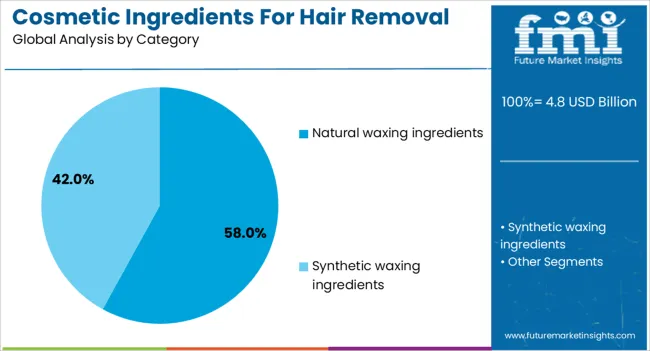
The natural waxing ingredients category is expected to account for 58% of the Cosmetic Ingredients for Hair Removal market revenue share in 2025, making it the dominant category. Growth in this segment has been supported by the increasing consumer shift toward organic and plant-based beauty solutions. Natural waxing ingredients offer enhanced skin compatibility, reducing the risk of irritation and allergic reactions, which is a key purchasing factor among modern consumers.
Manufacturers are prioritizing ingredients that meet clean beauty standards while delivering consistent hair removal performance. The versatility of natural ingredients in creating formulations for both professional salons and personal use has expanded their market appeal.
Additionally, the growing influence of eco-conscious consumers and stricter regulations on synthetic chemicals have encouraged wider adoption of plant-derived components The ability to align with sustainability goals while offering effective results has cemented the leadership of this category, which is expected to see continued demand across global markets.
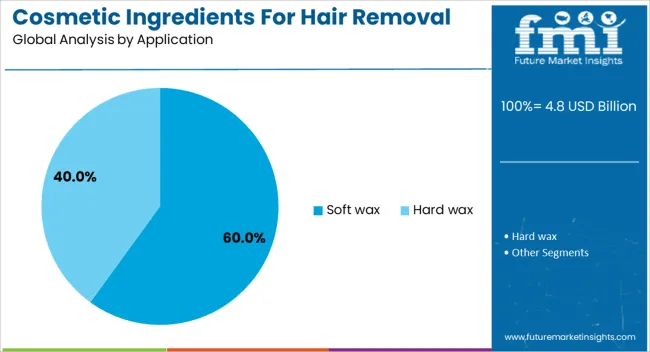
The soft wax application segment is anticipated to hold 60% of the Cosmetic Ingredients for Hair Removal market revenue share in 2025, making it the leading application. The segment’s success has been attributed to its effectiveness in removing fine and short hair over large skin areas, providing smooth results with minimal discomfort. Soft wax is preferred in both professional and home-use settings due to its ease of application, quick setting time, and suitability for various skin types.
The integration of natural and skin-soothing ingredients into soft wax formulations has further boosted consumer trust and repeat usage. Its compatibility with a wide range of substrates, including cloth strips, allows flexibility in application methods.
The growing popularity of at-home waxing kits has further fueled demand for soft wax, supported by marketing strategies that emphasize convenience and salon-like results As consumer grooming routines continue to prioritize efficiency and skin safety, this segment is expected to sustain its dominant position in the market.
The cosmetic ingredients for hair removal market is growing as demand for safer, more effective, and convenient solutions increases. Opportunities in both professional and at-home segments are expanding, with natural and botanical ingredients becoming a key trend. However, challenges related to regulatory compliance and market penetration persist. As manufacturers continue to innovate and meet consumer demands for gentle, effective hair removal products, the market is set for continued expansion.
The cosmetic ingredients for hair removal market is seeing rising demand as consumers seek safer, more effective solutions for hair removal. Traditional methods, such as shaving and waxing, are being replaced by more advanced options that offer longer-lasting results with less irritation. Ingredients like aloe vera, tea tree oil, and botanical extracts are increasingly used to enhance the soothing and skin-nourishing properties of hair removal products. As consumers prioritize convenience and skin safety, the market for gentle yet effective hair removal ingredients continues to expand.
The shift toward at-home hair removal solutions presents significant growth opportunities for cosmetic ingredient suppliers. Consumers are increasingly preferring professional-grade hair removal products for at-home use, driven by convenience and cost-effectiveness. Innovations in hair removal creams, gels, and strips that promise pain-free experiences are gaining traction. The demand for these products is fueled by busy lifestyles and the rising trend of self-care, creating a profitable opportunity for manufacturers to offer products that cater to both professional salons and individual consumers.
A prominent trend in the cosmetic ingredients for hair removal market is the incorporation of natural and botanical extracts. Ingredients like turmeric, chamomile, and witch hazel are being added to hair removal products for their anti-inflammatory, calming, and moisturizing properties. This shift is largely driven by consumer demand for products that combine beauty benefits with skin care. As people become more conscious of ingredient transparency and product safety, the market is leaning towards clean beauty formulations, which is likely to increase the popularity of plant-based hair removal solutions.
The cosmetic ingredients for hair removal market faces challenges in terms of regulatory compliance and ingredient safety standards. Different regions have varying regulations for cosmetic ingredients, which can complicate product development and distribution. Additionally, while consumer demand is high, market penetration is hindered by the complexity of formulating effective products that are both safe and gentle on the skin. Manufacturers must address these concerns by ensuring full compliance with regional regulations and emphasizing clinical testing to gain consumer trust.
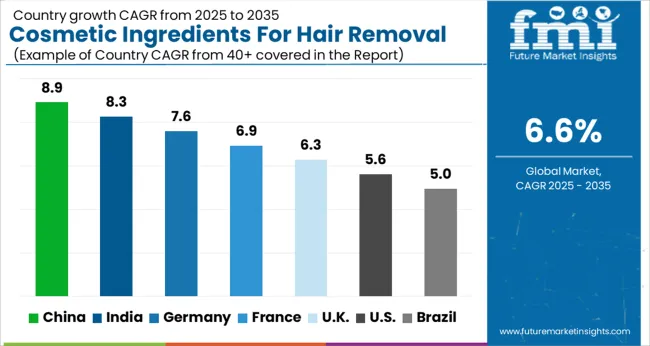
| Countries | CAGR |
|---|---|
| China | 8.9% |
| India | 8.3% |
| Germany | 7.6% |
| France | 6.9% |
| UK | 6.3% |
| USA | 5.6% |
| Brazil | 5.0% |
The global cosmetic ingredients for hair removal market is projected to grow at a CAGR of 6.6% from 2025 to 2035. China leads with a growth rate of 8.9%, followed by India at 8.3%, and Germany at 7.6%. The United Kingdom records a growth rate of 6.3%, while the United States shows the slowest growth at 5.6%. The demand for hair removal cosmetic ingredients is driven by increasing consumer interest in personal care and grooming, rising awareness of safe and effective hair removal methods, and advancements in formulations. Emerging markets like China and India are experiencing higher adoption due to rising disposable incomes, changing beauty standards, and growing demand for hair removal products, while mature markets such as the USA and the UK focus on premium products and advanced ingredients. This report includes insights on 40+ countries; the top markets are shown here for reference.
The cosmetic ingredients for hair removal market in China is projected to grow at a robust CAGR of 8.9%. Rapid urbanization, increasing disposable income, and growing awareness of personal grooming and beauty products drive demand in the country. China’s thriving beauty industry, alongside the increasing acceptance of advanced hair removal techniques, further accelerates the use of innovative ingredients. Additionally, the expanding e-commerce market in China provides greater accessibility to hair removal products, supporting growth.
The cosmetic ingredients for hair removal market in India is expected to grow at a CAGR of 8.3%. The market is driven by rising disposable incomes, evolving beauty standards, and increasing consumer awareness about safe hair removal methods. The demand for both at-home and professional hair removal solutions is growing, particularly with an increase in awareness of effective and chemical-free ingredients. With a rapidly expanding beauty and personal care sector, India is positioned as a key growth market for hair removal products.
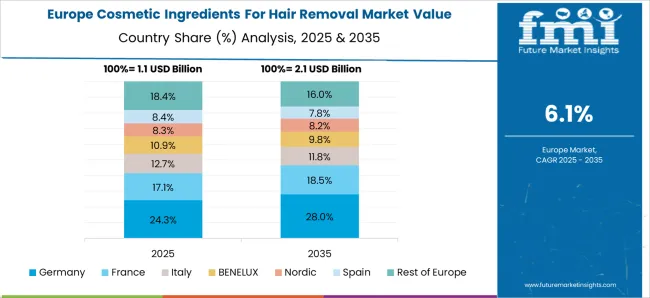
The cosmetic ingredients for hair removal market in Germany is projected to grow at a CAGR of 7.6%. Germany’s emphasis on high-quality, effective, and safe beauty products continues to drive the demand for advanced cosmetic ingredients for hair removal. The growing consumer preference for natural and eco-friendly ingredients, alongside increasing awareness of skin safety and comfort during hair removal, supports market growth. The country’s well-established personal care and grooming industry provides a strong foundation for ongoing market expansion.
The cosmetic ingredients for hair removal market in the UK is projected to grow at a CAGR of 6.3%. The UK’s beauty-conscious consumers are increasingly seeking safe and effective hair removal solutions, driving demand for advanced cosmetic ingredients. The growing trend for natural and sustainable beauty products further accelerates the market for hair removal ingredients, with both at-home and salon-based solutions gaining traction. Additionally, the rise of e-commerce platforms is making these products more accessible to a wider consumer base.
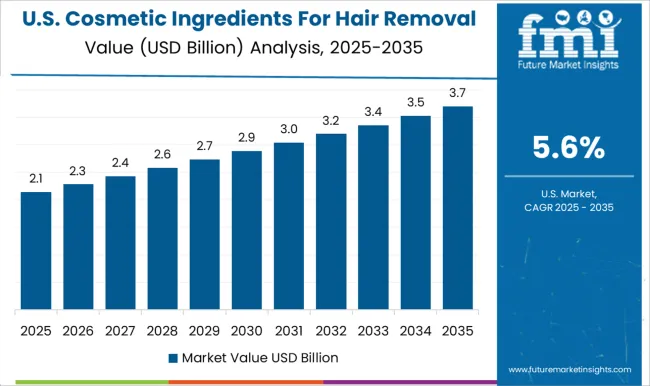
The cosmetic ingredients for hair removal market in the USA is projected to grow at a CAGR of 5.6%. Despite slower growth compared to emerging markets, the USA market remains strong due to high demand for premium, effective, and innovative hair removal solutions. With a growing emphasis on personal grooming and a wide variety of products available, consumers continue to prioritize high-quality, safe ingredients for hair removal. Additionally, the increasing trend of home-based grooming and professional treatments further contributes to steady market expansion.
The cosmetic ingredients for hair removal market is fiercely competitive, with major players such as Croda, BASF, and Clariant leading through their innovative product formulations. Croda's success stems from its focus on high-quality, skin-friendly ingredients, positioning itself as a key supplier in hair removal products that ensure both effectiveness and gentle application. BASF stands out by offering a broad portfolio, catering to both cosmetic and pharmaceutical needs, where its ingredients help enhance the performance of hair removal creams and gels. Clariant complements this with an emphasis on providing naturally derived, safe ingredients that meet stringent regulatory standards, solidifying its position among market leaders. Evonik, Ashland, and Stepan Company are also carving out their niches. Evonik’s product offerings are recognized for providing smooth texture and long-lasting results in hair removal formulations, allowing for a better user experience. Ashland differentiates itself with specialty chemicals designed for precision in hair removal applications, focusing on enhancing the comfort and sensory appeal of the end products. Stepan Company, known for its expertise in surfactants, supplies ingredients that boost the efficiency and spreadability of hair removal solutions. Each of these companies adopts a unique strategy of refining their formulations to meet consumer demands for effectiveness, safety, and comfort in hair removal products, while maintaining strong regulatory compliance. The competition is driven by a commitment to providing safe, high-performance ingredients that meet diverse regional demands.
| Item | Value |
|---|---|
| Quantitative Units | USD 4.8 Billion |
| Type | Glyceryl rosinate (rosin)/gum rosin, Hydrogenated rosin, Beeswax, Essential oils, Thioglycolic acid, Lanolin, Glycerin, and Others |
| Category | Natural waxing ingredients and Synthetic waxing ingredients |
| Application | Soft wax and Hard wax |
| Regions Covered | North America, Europe, Asia-Pacific, Latin America, Middle East & Africa |
| Country Covered | United States, Canada, Germany, France, United Kingdom, China, Japan, India, Brazil, South Africa |
| Key Companies Profiled | Croda, BASF, Clariant, Evonik, Ashland, Stepan Company, and Other suppliers |
| Additional Attributes | Dollar sales by ingredient type (enzymes, acids, resins, emulsifiers), Dollar sales by product form (creams, gels, waxes, sprays), Trends in natural and organic ingredient adoption, Growth in demand for pain-free and sensitive-skin formulations, Regional patterns of hair removal ingredient usage across personal care and dermatological sectors, Innovations in long-lasting and effective hair removal solutions. |
The global cosmetic ingredients for hair removal market is estimated to be valued at USD 4.8 billion in 2025.
The market size for the cosmetic ingredients for hair removal market is projected to reach USD 9.1 billion by 2035.
The cosmetic ingredients for hair removal market is expected to grow at a 6.6% CAGR between 2025 and 2035.
The key product types in cosmetic ingredients for hair removal market are glyceryl rosinate (rosin)/gum rosin, hydrogenated rosin, beeswax, essential oils, thioglycolic acid, lanolin, glycerin and others.
In terms of category, natural waxing ingredients segment to command 58.0% share in the cosmetic ingredients for hair removal market in 2025.
Explore Similar Insights

Thank you!
You will receive an email from our Business Development Manager. Please be sure to check your SPAM/JUNK folder too.
Chat With
MaRIA